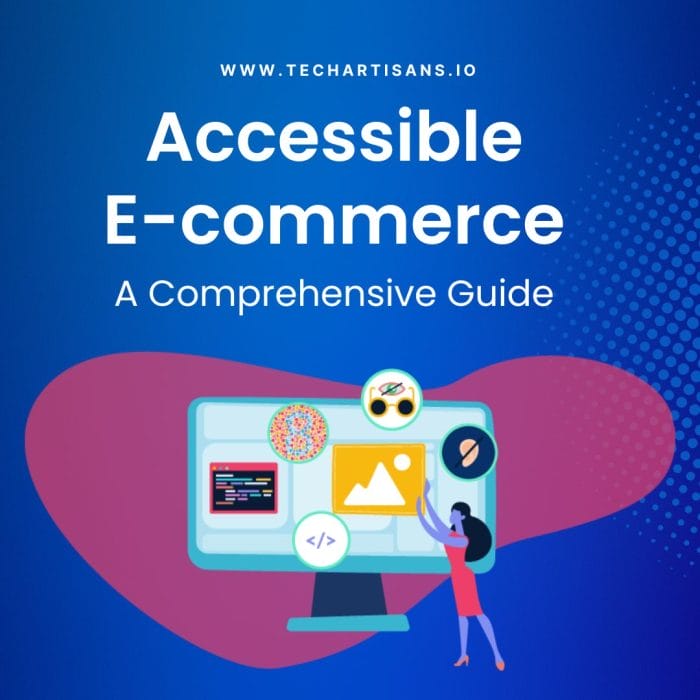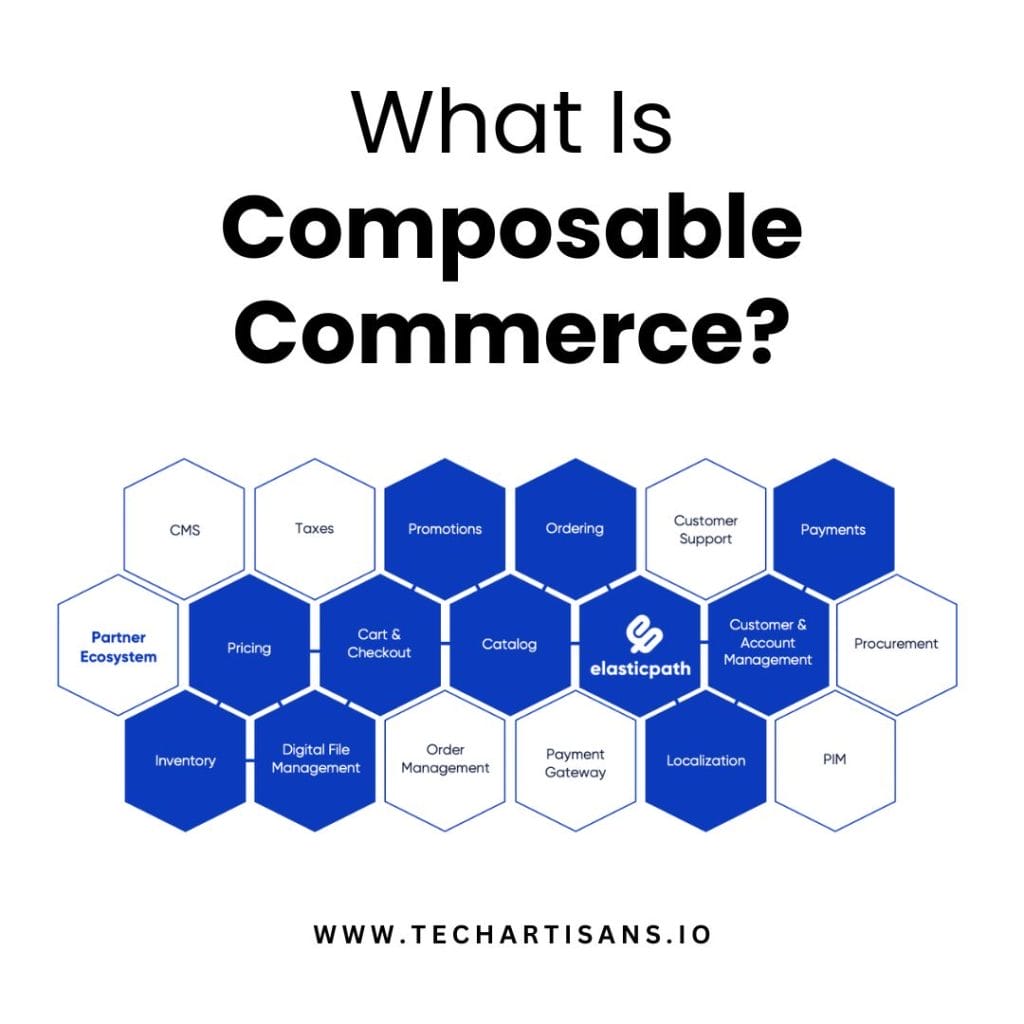The internet should be accessible to everyone, regardless of their abilities. In its early days, many websites posed barriers to make website accessible people with hearing, motor, or visual impairments. Limited site-accessible options were available.
Today, the situation has improved for online shopping by people with disabilities. Guidelines from the Americans with Disabilities Act (ADA) and the World Wide Web Consortium have facilitated web accessibility. Assistive technologies have also emerged, allowing developers to enhance ecommerce website accessibility for all users.
Here’s a brief web accessibility manual – best practices for your e-commerce website accessibility and current web accessibility standards and solutions you can implement in the web design for your ecommerce site.
What is Ecommerce Website Accessibility?
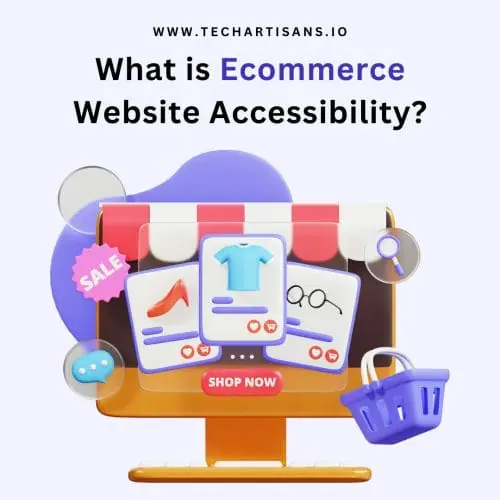
Web accessibility means creating websites and web applications that are usable by a diverse range of individuals, regardless of physical or cognitive abilities. This concept ensures equitable access to online information in today’s integral digital landscape.
A complete ecommerce website accessibility offers a positive user experience for all, including those with visual, auditory, motor, or cognitive challenges. During the development phase, developers proactively address potential digital accessibility issues and design applications with inclusivity in mind.
Ecommerce Website Accessibility Challenges for Disabled Users:
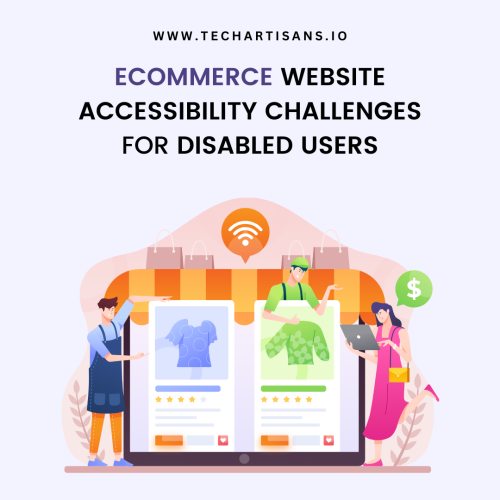
Common challenges that can hinder disabled users from navigating your ecommerce website include hearing impairments, visual impairments, mobility limitations, language barriers, and learning difficulties.
1. Considerations For Visually Impaired
For visually impaired individuals (such as color blindness, low vision, blindness, presbyopia, nearsightedness, and deaf-blindness), specific challenges arise:
- Inability to enlarge images, text, or layouts, resulting in lost information.
- Inaccessible page structure, orientation cues, and browsing aids.
- Insufficient contrast between foreground and background in images and text.
- Lack of text or audio alternatives for video content.
- Complex and inconsistent navigation leads to confusion.
- Limited keyboard support due to inaccessible websites, browsers, and authoring tools.
2. Considerations for Users with Hearing Impairments
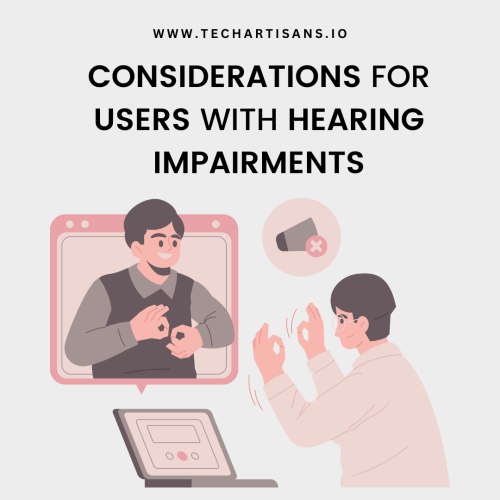
Given the prevalence of hearing impairments, it’s important to cater to customers who are partially or fully audibly impaired.
Challenges they might encounter include:
- Lack of subtitles or transcripts for audio content like videos.
- Inadequate caption display and volume control in media players.
- Web services and applications rely solely on voice interactions, excluding them.
3. Considerations for Neurological and Cognitive Disabilities
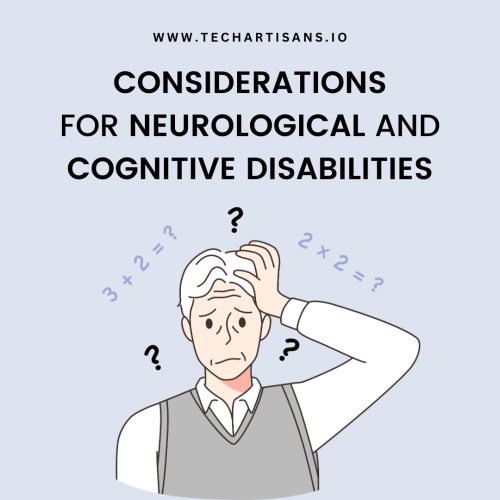
People with disabilities like Autism Spectrum Disorder (ASD), ADHD, intellectual disabilities, and more may require tailored digital accessibility.
They could face challenges such as:
- Complex navigation and layouts cause confusion.
- Lengthy text passages lack visual aids for context.
- Uncontrollable flashing content and background sound.
- Absence of options to remove animations and audio in web browsers and media players.
- Inability to adapt visual page designs through browser controls or custom styles.
4. Considering Users with Physical Disabilities
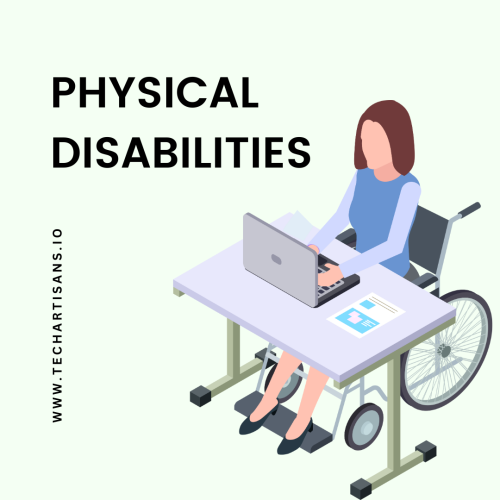
People with disabilities like reduced dexterity, amputation, muscular dystrophy, and more, require special attention.
User Challenges to address:
- Lack of full keyboard support in web browsers, sites, and authoring tools.
- Limited response time or task completion window, like filling out forms.
- Absence of clear visual and non-visual navigational cues.
- Unpredictable and complex page functions, hindering navigation consistency.
Best Practices for Ecommerce Web Accessibility Standards
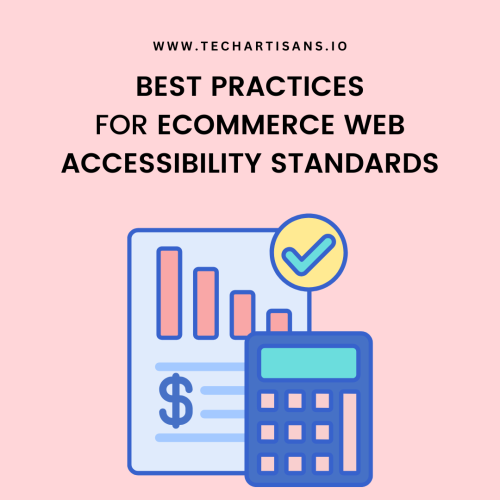
Web developers use the acronym POUR to outline ecommerce web accessibility:
- Permeability: Content can be interpreted by one or more senses. This includes visual, auditory, and tactile experiences for users, accommodating tools like screen readers or braille displays.
- Operability: Users can interact in ways that suit them, using inputs like typing, tapping, or even assistive tools like eye trackers for those with limited motor skills.
- Understandability: Content is clear and logical, benefiting users with diverse cognitive and physical capabilities. Consistency in design and placement enhances comprehension.
- Robustness: Content functions across devices, catering to digital accessibility tools such as text-to-voice software that aid users in understanding multimedia elements.
What are the Guidelines for Accessible Ecommerce Websites?
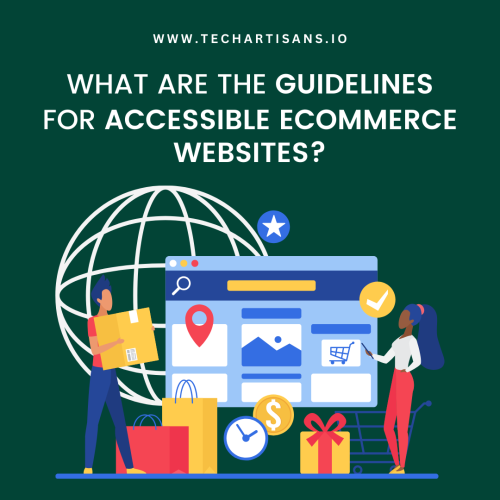
Numerous organizations and governments have established web accessibility guidelines to foster fairness among internet users. Below are key bodies and their accessibility standards:
Web Content Accessibility Guidelines (WCAG): WCAG offers a comprehensive global framework for accessible web design, formulated by the World Wide Web Consortium (W3C) within the Web Accessibility Initiative–Accessible Rich Internet Applications (WAI-ARIA).
W3C’s authoring tool guidelines span desktop web browsers, mobile apps, and internet-connected applications like screen readers. The principles encompass:
- Text alternatives for non-text content: Non-text elements like videos and graphics should be accompanied by summarizing text descriptions, known as alt text or you can create sign language videos for the important content.
- Multimedia alternatives: Video captions, transcripts, and sign language interpreters provide options for comprehending audio content.
- Flexible presentation: Enabling user customization for content comprehension, such as text enlargement or audio playback of text blocks.
- Enhanced perception: Encouraging resizable text and images, avoiding sole reliance on color for differentiation, and minimizing automatic music playback.
- Clear legibility: Legal documents online, like contracts, require readable fonts and downloadable accessibility. In embracing these principles, web creators ensure equitable online access for all.
Americans with Disabilities Act (ADA) – U.S. Federal Government
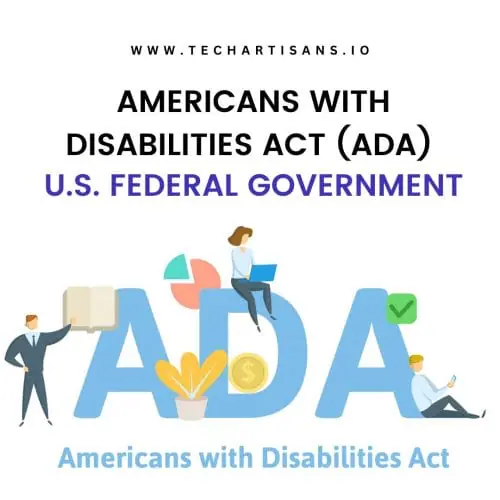
The ADA, established in 1990 to combat ability-based discrimination, applies to government entities and private firms with 15+ employees. For government and private entities, the ADA mandates accessible ecommerce websites for vital services like voting registration, tax filing, benefits applications, police reporting, and fee payments.
Private company websites under the ADA lack specific mandates, but all public-access businesses must offer effective communication aids for people with disabilities. The U.S. Department of Justice asserts that inaccessible features can hinder disabled users’ access to services. While not outlining precise requirements to make online store accessible, the department encourages robust accessibility and references WCAG standards for web developers.
EU Web Accessibility Directive
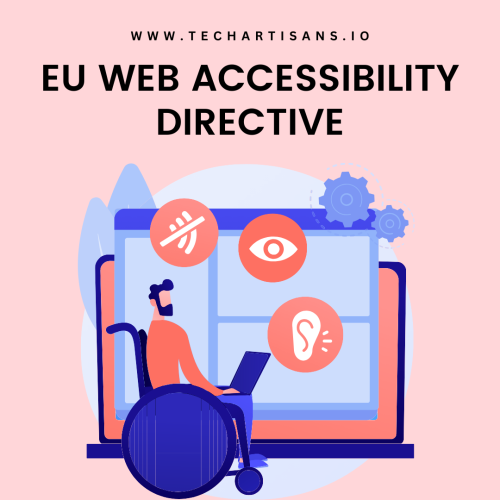
The EU’s directive on web accessibility outlines criteria to access web content across desktop and mobile platforms in member states. Key aspects of this initiative involve:
- Accessibility Statements: Inclusion of statements on ecommerce sites and mobile apps, acknowledging inaccessible components, and presenting alternatives.
- Feedback Mechanism: Mandatory provision of a feedback avenue on an ecommerce website and app, allowing users to report accessibility issues or seek clarifications about non-accessible content.
- Public Website Monitoring: Regular monitoring of public websites and apps engaged in public communication or governmental activities, with mandatory reporting to the European Commission every three years.
Enhancing Ecommerce Website Accessibility
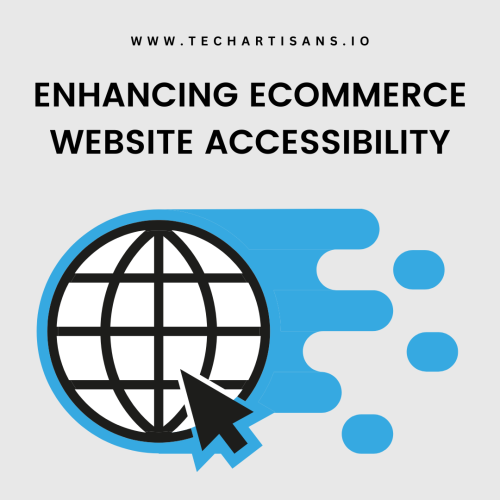
Upgrading your ecommerce website for maximum accessibility yields business advantages, fostering broader engagement through diverse content formats. Optimize your website’s accessibility for a wider visitor base with the following methods:
1. Alt Text for Visually Impaired User
Use descriptive alt text for images and videos, aiding both visually impaired users and those who don’t have a stable internet connection.
2. Video Captions
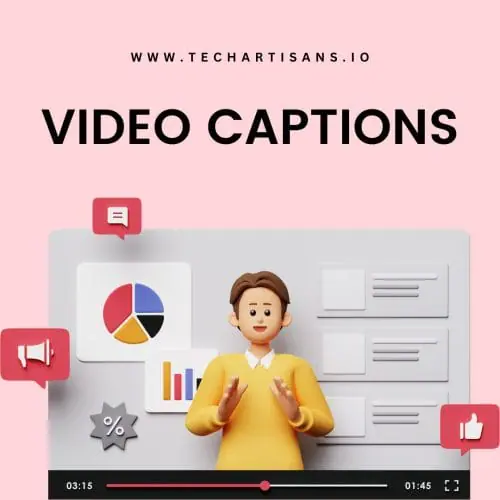
Add closed captions to videos, aiding users with hearing impairments or situations requiring muted audio.
3. Optimal Color Use
Employ high-contrast color schemes for clarity in charts, graphs, and maps. Consider colorblindness by using contrasting color patterns and additional visual cues.
4. Minimize Flashing
Avoid blinking and flashing elements to prevent distractions and potential seizures.
5. Perceptibility

Utilize assistive tools like screen readers, text-to-speech systems, and content descriptions for videos.
Just a few examples of how you can improve perceptibility on your own online store website are:
- Provide text alternatives for non-textual elements, adaptable for different presentations.
- Include sign language interpretation for pre-recorded audio descriptions.
- Allow adaptable content presentation without loss of information.
- Ensure content remains intact across orientations and devices.
- Enable auto-fill for common fields (e.g., name, address).
- Enhance visual and auditory separation for content perception.
- Implement thorough alt attributes for images, enhancing both accessibility and search engine optimization.
6. User-Friendly
A superior ecommerce website design ensures that users can easily navigate websites and complete tasks completion, crucial for tasks like E-commerce transactions. The clarity in usage and proper content interpretation by browsers is essential.
How to Make Your Online Store User-Friendly:
- Allow users ample time for content perusal and interaction.
- Avoid rapid flashing content that might trigger seizures.
- Provide navigation aids for content exploration and user orientation.
- Use descriptive element names to clarify roles, like adding “aria-label” attributes to buttons for improved understanding.
7. Understandability

Content clarity is paramount, catering to users of all cognitive abilities, including those with learning or reading challenges. Vital for forms, ensuring straightforward completion is key.
How to Improve Understandability On Your Online Store:
- Ensure web pages appear and operate as expected.
- Opt for readable content with clear vocabulary and user-friendly fonts.
- Guide users in preventing and rectifying input errors.
- Minimize user-required actions; for instance, employ “autocomplete” attributes on forms to simplify data entry based on browser settings.
8. Stability

Ensure content can be consistently interpreted by both current and upcoming assistive technologies.
How to Improve the Stability of Your Online Store:
- Enhance compatibility with present and future browsers.
- Collaborate with a skilled accessibility specialist for informed design, especially crucial for E-commerce.
- Structure your E-commerce platform meticulously, adhering to proper element nesting, tag completeness, absence of duplicate attributes, and unique IDs.
9. Thoughtful Video Playback
Refrain from autoplay videos and audio, allowing user-controlled playback and enabling compatibility with screen readers.
To implement these strategies, leverage your ecommerce website builder’s tools or collaborate with specialized vendors in accessible communication technologies. These experts can enhance your ecommerce site accessibility or assist in constructing an inclusive ecommerce website.
Testing Ecommerce Website Accessibility
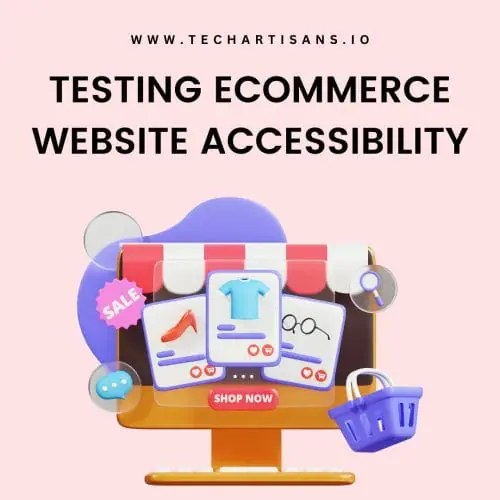
Evaluate your ecommerce website accessibility with effective assessment tools. Consider these three options:
- SortSite: An automated tool that checks device compatibility, accessibility, SEO, broken links, and security.
- WAVE: This tool uses simulated web browsers to assess ecommerce site functionality against WCAG guidelines after inputting your ecommerce site URL.
- Color Contrast Accessibility Validator: Audits color contrast, offering suggestions for improved accessibility, particularly for colorblind website users. Leveraging such tools not only ensures compliance but also lowers maintenance expenses, as they seamlessly adapt to updated content.
Importance of Ecommerce Website Accessibility
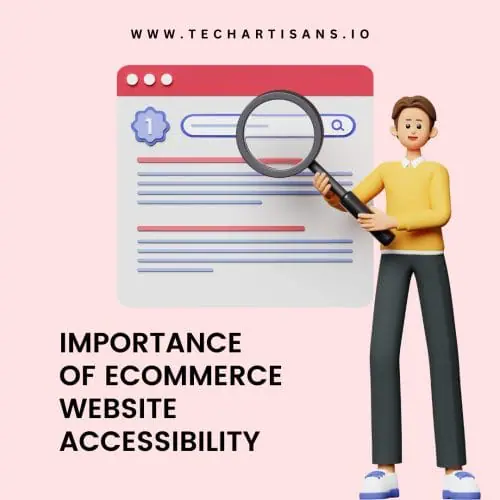
E-commerce website accessibility holds significance for two core reasons. Firstly, it empowers individuals with disabilities to seamlessly engage with e-commerce websites. Secondly, ADA compliance and WCAG compliance ensure search engines and indexing tools can comprehensively access your site’s content.
In the US, a substantial portion of the population (and your potential customer base) greatly relies on ecommerce website accessibility and expect websites to address various shopper limitations:
- Approximately 9.6% (~2.6M) exhibit motor limitations.
- About 3.9% (~1.4M) have cognitive limitations.
- Around 4.8% (~1.3M) experience hearing limitations.
- Approximately 5.4% (~1.5M) are visually impaired.
A responsive and accessible ecommerce website opens doors for your entire audience, enabling them to explore and shop in your online stores. These measures can even lessen reliance on customer service teams. An interactive, personalized customer journey fosters autonomy and significantly enhances customer satisfaction, ultimately benefiting your brand.

